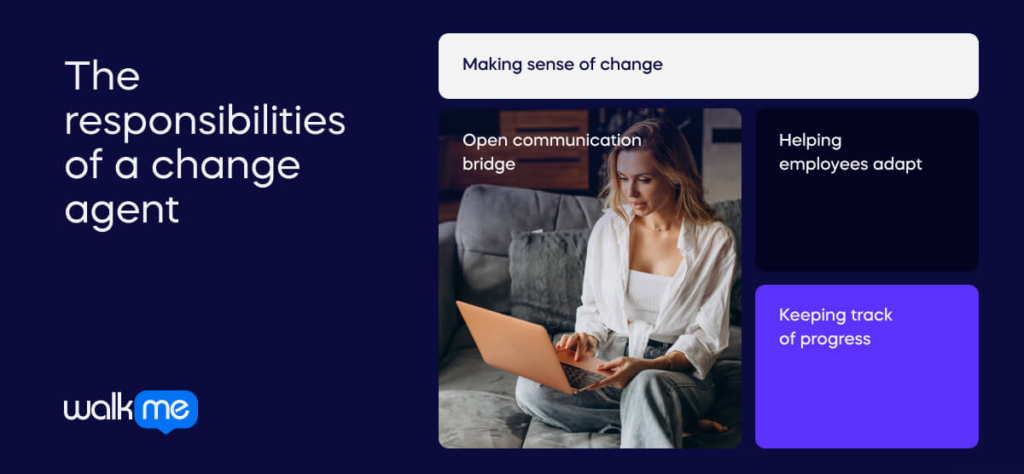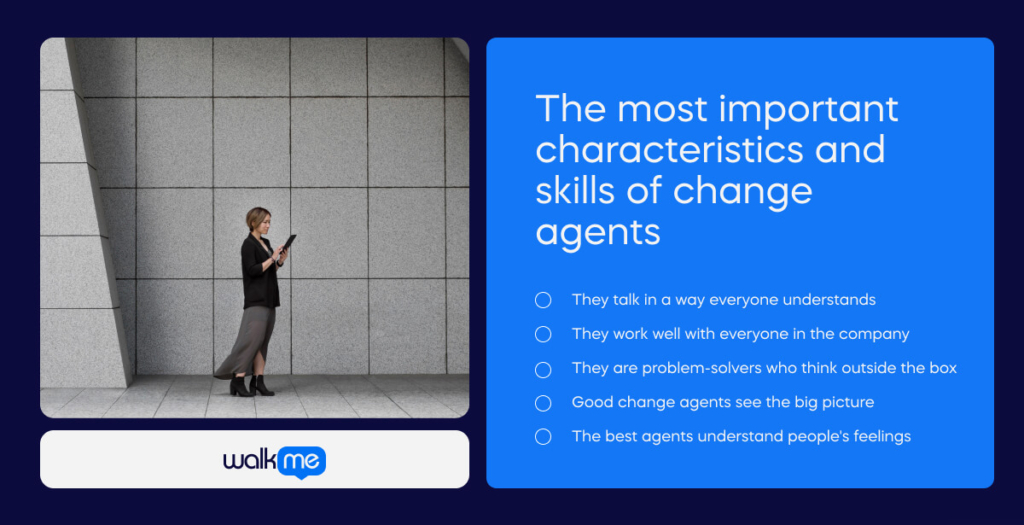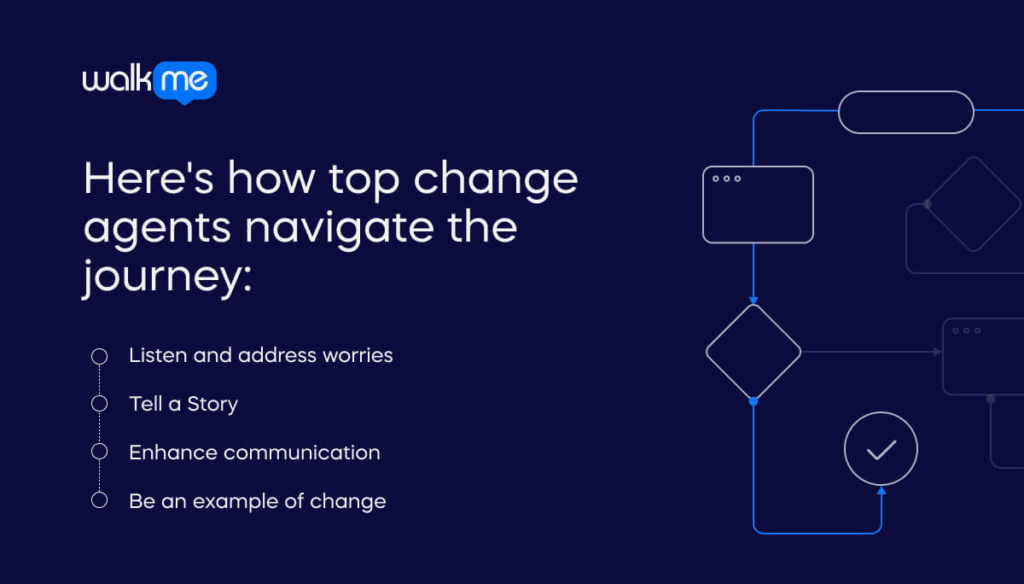Making progress requires change.
Customers want different things, there’s more competition than ever, and new technology keeps popping up. This means today’s business leaders must swap out traditional practices for new ways of doing things.
Affecting change across a large workforce isn’t easy. People get used to working a certain way, and it can be hard to shift their mindset.
One way to overcome these challenges is through change agents. These people help employees understand the change and why it’s happening.
They answer questions and make the change seem less scary. However, the most important thing they do is help employees start thinking differently about their work. This change inside employees’ heads makes a difference in the long run.
In this article, we’ll dive deep into what a change agent is, exploring their different types, roles, and the skills they need to be successful. We’ll also unpack why change agents are essential for building an agile workforce – one that’s fully prepared to embrace new challenges and disruptions that come their way.
What is a change agent?
A change agent is a champion for progress within a company. They bridge the gap between the need for change and its successful implementation. This change is driven through clear communication, addressing concerns, and helping employees adapt.
They play a key role in helping the organization adapt to new situations. This could also include ramping up digital adoption or process improvements. A change agent can be almost anyone in an organization. They might be supervisors, team leaders, or even regular employees who step up to champion the new way of doing things.
A dedicated change manager focuses on the overall plan and strategy. In comparison, change agents are the folks who make change happen on the ground.
Let’s explore the different roles of those who are affecting change across an organization.
Change management roles: Agents, champions, and leaders
Navigating an organization through change requires a diverse cast of characters.
Many terms get tossed around when discussing change in a company: change agent, champion, leader. While they might sound similar, there are key differences in what each person does.
Let’s unpack each title to understand their unique contributions.
- Change agent: They notice when things need to shift. Whether it’s because of new tools everyone uses or because other companies are stealing customers. They are adept at explaining the “why” behind the change clearly and concisely. They answer employee questions, address worries, and act like a bridge between the bosses and the rest of the company.
- Change champion: Change champions are enthusiastic supporters who rally behind the change initiative. They use their influence and communication skills to create employee excitement and buy-in. Change champions often come from various levels of the organization, acting as vocal advocates for the new way of doing things.
- Change Leader: Change leaders hold the reins of the change process. They get the go-ahead to decide what needs to happen, get the tools and people they need, and ensure the change helps the company reach its goals. They often have a team to help them and are responsible for ensuring the whole change goes well.
While these roles detail specific roles and responsibilities, there is often overlap in practice. Change agents can emerge as champions, and effective leaders will champion the change they lead.
Understanding the different types of change agents
Sudden shifts to how people work, what they do, or how things get done can derail even the smoothest-running company. But not all these changes are the same. As such, different changes require different agents.
Here’s a breakdown of different types of change agents and common focus areas of managing change:
- People-focused change agents: These “people people” understand the human side of change. They excel at explaining the “why,” addressing concerns and helping employees adjust to new ways of working. They specialize in communication, training, or employee engagement.
- Process-focused change agents: They study how things are done now, figure out what could be better, and help implement those better ways. They might have expertise in lean manufacturing, Six Sigma, or project management.
- Organizational change agents: Big-picture thinkers. These agents focus on the change’s overall impact on the organization. They ensure it aligns with company goals and resources are allocated effectively. They might have experience in organizational development, change leadership, or business transformation.
Other titles in the change management landscape
Depending on the change, there might be a need for agents with a broader range of titles. These include specific functions and expertise in other focus areas. These include:
- Technology change agents: These agents help companies adopt new tools like cloud computing or AI. They learn how to train employees and make the new tools work with the old ones.
- Cultural change agents: Culture champions focus on shifting company culture to support desired change initiatives. They might champion programs that promote fairness and teamwork in the company. This could include promoting diversity initiatives or creating a more collaborative work environment.
- Project manager: The project manager is the engine driving the day-to-day execution of the change. They oversee tasks, manage resources, and ensure the project stays on track. In complex change initiatives, a matrix management structure might be implemented. This means the project manager may share authority with other departments or leaders with a stake in the change.
- Change management consultant: Brings specialized change know-how to the table. They figure out if the company is ready for change, make a plan to get there and spot any problems that might slow things down. They also provide ongoing support to ensure a smooth and successful transformation.
- Resistance manager: Focuses on anticipating and mitigating employee resistance. They understand the problems causing resistance and come up with solutions. This makes the change process smoother.
Internal vs. external change agents
We’ve explored the different levels of change agents’ responsibility within a company. These roles aren’t only limited to internal employees. Change efforts can also come from outside the company.
Sometimes, businesses bring in special change agents trained to help with change. These are called external change agents—experts who can guide everyone through the process.
To better understand, let’s break down the differences in both internal and external change agents.
Internal change agents
Internal change agents are company veterans who push for change within their teams. They know the company culture, workflows, and employee concerns inside out. This insider knowledge builds trust and lets them tailor their message to resonate with colleagues. They often share a stake in the company’s success, making everyone feel invested in the change.
However, being too familiar with the “old ways” can be a drawback. Internal agents might struggle to see past set norms or predict resistance from close colleagues.
External change agents
External change agents bring a brand new perspective and specialized skills. They’ve worked with other companies facing similar problems, so they know what works and what doesn’t. Their outsider view can spot hidden inefficiencies or biases that internal agents might miss.
The catch? External agents don’t know the company culture or internal politics as well. Building trust and rapport with employees can take longer, potentially slowing things down. Plus, their fees can be a big expense.
What are the responsibilities of a change agent?

Change can be a headache when adopting new systems, different processes, or unfamiliar workflows. These can all disrupt our familiar work routine. Change agents are the solution, helping businesses navigate the choppy waters of transformation.
Here’s a breakdown of their key responsibilities:
Making sense of change
Change agents take complicated plans and explain them clearly. They tell the story of “why” the change matters and how it helps everyone. They explain the benefits and how it fits with individual career paths.
Open communication bridge
They connect leadership and employees, encouraging open discussions. They listen to concerns, find solutions that address worries, and make employees feel involved in the change.
Helping employees adapt
Change agents create training programs and share resources. This allows employees to learn new skills needed for the change. They might even mentor fellow employees through the learning process.
Keeping track of progress
They monitor progress, gather feedback, and adjust plans to ensure the change works in the long run.
What are the most important characteristics and skills of change agents?

Leading change requires a specific skill set. As the navigators of transformation, change agents should possess these key strengths:
Great change agents talk in a way everyone understands.
They don’t just announce a change; they explain it step-by-step. They also show people the reasons for the change and how it helps the company and everyone working there.
They work well with everyone in the company.
They build relationships with leaders and with all employees. They ensure everyone feels like their voice matters and that they’re part of the changes.
They are problem-solvers who think outside the box.
They don’t give up when things get tricky. Instead, they look at problems from all sides and find ways to keep moving forward.
Good change agents see the big picture.
They understand how the change fits into the company’s future goals.
The best agents understand people’s feelings.
They know that change can be scary or exciting. They listen to those feelings and help everyone feel positive about the changes.
Change agent best practices: Making change smooth-sailing
Guiding change requires a specific skill set. These techniques can turn a change agent into a transformation champion.

Here’s how top change agents navigate the journey:
1. Listen and address worries: Change can be nerve-wracking. Great change agents listen closely to what employees are worried about. They tackle these concerns head-on by having open discussions. This creates a safe space for honest talk and builds trust with the team. B
2. Tell a Story: Change agents craft clear, engaging stories that explain the “why” behind the change and what’s coming down the pipeline. These stories paint a picture of success, highlighting benefits for the company and individual employees. They even offer a sneak peek at the journey, outlining the beginning, middle, and end stages. This approach helps everyone feel like they’re on the same team, working in the same direction.
3. Enhance communication: Today’s technology has enabled lightning-fast communication. Change agents can use all sorts of tech tools to chat with everyone. They can use company websites and social media groups. Or even make video messages to keep everyone informed, answer questions, and have a two-way conversation.
4. Be an example of change: Change agents aren’t just planners but also role models. Showing the desired behaviors and staying positive about the shift inspires and motivates others to jump on board. They don’t just tell people what to do; they show them. By acting the way they want others to act and staying optimistic, they get everyone excited about the new course the ship is taking.
Change is the only constant: Let change agents lead the way
The world never stays still, and neither should businesses. Remember when everyone’s favorite video rental store was Blockbusters? They got stuck while Netflix was quickly bringing streaming services to the masses.
Change agents understand that you’ve got to keep up with the times. Research from McKinsey found that only half of business leaders feel ready for unexpected challenges. Plus, two-thirds think their companies are too complicated and slow to change.
Importantly, you don’t need a fancy job title to be a change agent. It’s about honing your skills in tactical thinking, problem-solving, and bringing people together.
People with a problem-solving mindset are often natural change agents. If you see problems and think of ways to solve them, you have the potential to make a difference at your company.


